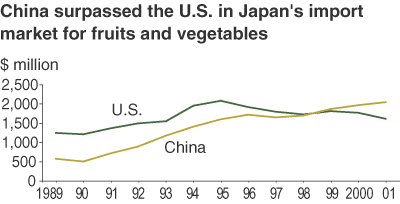China’s Vegetable Exports Challenge the U.S. in Japan’s Market
- by Sophia Huang
- 11/1/2003
Technological investments in China’s vegetable sector and port facilities have paved the way for an expansion in its vegetable exports, particularly to Japan, where China and the United States have long been the two leading fruit and vegetable suppliers. In 1999, China displaced the United States as the leading supplier for Japan, and has since improved that position.
Japan is second only to Canada as the top market for U.S. fruits and vegetables, receiving $1.3 billion—or nearly one-fifth—of U.S. fruit and vegetable exports during 1999-2001. French fries, processed sweet corn, and fresh produce such as grapefruits, cherries, oranges, and broccoli are top U.S. exports to Japan. In fact, Japan led the rapid export growth of U.S. produce to Asia between the mid-1980s and mid-1990s, when advances in transportation, shipping, and handling enabled trade in fresh, versus processed, fruits and vegetables. Asia surpassed the European Union as the leading destination for U.S. fruit and vegetable exports outside North America in the early 1990s.
China targeted Japan as its top market for fresh and processed vegetables during the 1990s. Starting with a 6-percent share of Japan’s fresh vegetable import value in 1990, China became Japan’s leading supplier by 1996 and reached a 38-percent share in 2001. China’s exports included broccoli, onions, and asparagus, competing with leading U.S. vegetable exports.
Similarly, China’s share of Japan’s import market for processed vegetables and fruits more than doubled in the 1990s to reach 53 percent in 2001. The U.S., however, remains a strong competitor in the Japanese market for frozen potatoes and processed sweet corn, where China is not a player. Overall, the U.S. share of Japan’s import market stood at less than 19 percent for fresh vegetables and 21 percent for processed products in 2001. The respective shares for other countries in the Japanese market were 43 percent and 26 percent in 2001.
China’s rising vegetable exports to Japan were bolstered by many factors. With its low production costs and geographic proximity to Japan, China attracted foreign investment, especially from Japanese trading companies. These businesses provided the seeds, spores, and production/packing techniques, and imported the harvest for Japanese retailers. Improved ocean freight service from major Chinese ports to Japan also increased China’s competitiveness.
Recent trade friction with Japan over chemical residues on Chinese vegetables could prompt changes in production practices and greater inspection. These added costs could reduce China’s competitiveness. However, with its low labor costs, China will likely continue to be a formidable competitor with the United States in Japan, particularly for fresh vegetables.
This article is drawn from:
- China Increases Exports of Fresh and Frozen Vegetables To Japan. (2002). USDA, Economic Research Service. VGS292-01..


